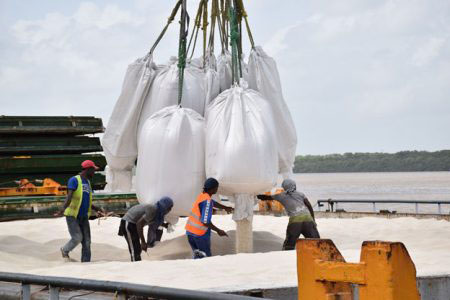With cross-border access into Guyana having long been relatively easy, protecting the country’s territory must focus not only on keeping undesirable elements out but also on protecting the population from ‘invasion’ by non-human yet harmful elements that could compromise the nation’s security no less seriously than armed invasion.
Part of the responsibility of, as far as possible, keeping undesirable elements out falls to the Quarantine Department that functions under the National Agricultural Research and Extension Institute (NAREI) of the Ministry of Agriculture. The Quarantine Department executes its regulation, facilitation, administration and quarantine treatment at the country’s official ports of entry viz the Cheddi Jagan International Airport (CJIA), Ogle International Airport (OAI) as well as the Stabroek Market Wharf , the Molsen Creek Ferry Service, Springlands, Charity and Parika stellings as well as the various container terminals within Georgetown.
In its recently released 2016/2017 report NAREI reports that a total of 3,489 checks were recorded at these various points in 2017, a number representing 174 percent of the targeted frequency.
And NAREI reports that successful trials in the cultivation of potato and onion locally did not preclude the high importation of these commodities as well as garlic, wheat and spices into Guyana.
With smuggling still rampant NAREI discloses in its 2017 annual report that its Quarantine Department effected 347 “interceptions/rejections during the reporting period”. At the same time and mindful not to interrupt the flow of various agricultural commodities into the country the Department issued four hundred and fourteen Import Permits which, the report says, represented 138% of the targeted frequency for the year.
In 2017 the Quarantine Department also placed emphasis on inspecting shipping vessels entering Guyana’s ports. The report says that during the reporting period the Department inspected 1,483 ocean-going vessels “to ensure compliance with phytosanitary requirements” for all vessels entering the country’s territorial waters. The report adds that since all of the vessels were found to be in compliance with the country’s phytosanitary requirements they were permitted to enter the country’s waters.
During the reporting period, according to NAREI, 3,547 flights were inspected at CJIA and OAI. In the instance of aircraft the prerogative of Quarantine officials extend to passengers’ baggage and cargo. The Quarantine officials are also charged with ensuring that all international garbage is appropriately disposed of.
Local Quarantine officials were also last year, preoccupied with the inspection of vehicles entering or leaving Guyana. These, the report says, were “subjected to inspection and phytosanitary treatment to eliminate the possibility of pests entering or leaving Guyana. A total of 32,771 vehicles were inspected under such conditions last year.
With rice exports continuing to play an important part in the country’s foreign exchange earnings particular attention was paid to the quality of rice leaving the country and during the reporting period a total of 4, 869 pre export rice fumigations were executed. Similar vigilance was exercised with other agricultural commodities with a reported 7,596 inspections of exported agricultural commodities and “regulated articles” carried out in order “to ensure compliance with importing countries’ phytosanitary requirements.” NAREI says that the major commodities inspected for export during the period included rice, sugar, lumber, fruit, vegetables, sand and charcoal. During the reporting period the Department issued 3,922 phytosanitary certificates.
Meanwhile, for the 2016-17 reporting period a total of 366 farm visits were made by the Quarantine Department and 137 farms were certified for the export of fresh fruit and vegetables in 2017.






